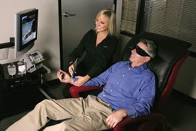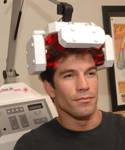Low-level Laser Therapy
Low-level laser therapy (LLLT) is a medical and veterinary treatment that uses low-level lasers or light-emitting diodes to alter cellular function. LLLT is controversial in mainstream medicine with ongoing research to determine the ideal location of treatment (specifically whether LLLT is more appropriately used over nerves versus joints), dose, wavelength, timing, pulsing and duration. The effects of LLLT appear to be limited to a specified set of wavelengths of laser, and administering LLLT below the dose range does not appear to be effective.
Despite a lack of consensus over its ideal use, specific test and protocols for LLLT suggest it is effective in relieving short-term pain for rheumatoid arthritis, osteoarthritis, acute and chronic neck pain, tendinopathy, and possibly chronic joint disorders.] The evidence for LLLT being useful in the treatment of low back pain, dentistry and wound healing is equivocal.
History
In 1967 a few years after the first working laser was invented, Endre Mester in Semmelweis University in Budapest, Hungary experimented with the effects of lasers on skin cancer. While applying lasers to the backs of shaven mice, he noticed that the shaved hair grew back more quickly on the treated group than the untreated group.
Clinical applications
LLLT has primarily been shown useful in the short-term treatment of acute pain caused by rheumatoid arthritis, osteoarthritis, tendinopathy, and possibly chronic joint disorders. LLLT has also been useful in the treatment of both acute and chronic neck pain. A Cochrane Library review concluded that there is insufficient data to draw a firm conclusion on the clinical effectiveness of low-level laser therapy for low back pain, a finding echoed in a later review of treatments for chronic low back pain. Though it has been suggested for decades that LLLT could be useful in speeding wound healing, the appropriate parameters (dose, type of laser, materials, wavelength, etc.) have not been identified. Similarly, the use of lasers to treat chronic periodontitis and to speed healing of infections around dental implants is suggested, but there is insufficient evidence to indicate a use superior to traditional practices. Insurance company Cigna has reviewed the evidence for LLLT and concluded that it is still considered an experimental treatment therefore does not provide coverage for it.
Low-level laser therapy for smoking cessation operates on principles similar to the 5,000 year old ancient Asian healing art of Acupuncture. Acupuncture is known to reduce tension, increase circulation, and enable the body to relax more deeply.
 After 35 years of use internationally in Europe and Canada low-level laser for nicotine addiction is available through clinical research trials in the United States. Low-level laser is being studied to see if it promotes the release of endorphins in the body. Endorphins are natural chemicals in your body that signal your system to decrease stress and increase energy.
After 35 years of use internationally in Europe and Canada low-level laser for nicotine addiction is available through clinical research trials in the United States. Low-level laser is being studied to see if it promotes the release of endorphins in the body. Endorphins are natural chemicals in your body that signal your system to decrease stress and increase energy.
Freedom uses a low-powered (soft) laser no more powerful than a light bulb. Laser is applied to energy points related to addiction. The Laser Therapy procedure is external, non-invasive, drug free, and non-thermal.
During the laser session energy is applied to points on your hands, face, wrist, and ears. If a client feels the sensation from the low-level laser, they may feel a warm, pulsating and sometimes-tingling feeling.
Laser Hair Therapy
 LLLT is defined as "a cool laser that effectively stimulates the area and causes an increase in blood flow and causes Photo-bio-stimulation".
LLLT is defined as "a cool laser that effectively stimulates the area and causes an increase in blood flow and causes Photo-bio-stimulation".
Photobiostimulation is the biochemical, non-thermal effect that results from the exposure of living tissue to various dosage of energy at varying wavelengths emitted from low level lasers.
Five distinct effects are know to occur:
• An increase in ATP (Adenosine Triphosphate) and protein systhesis - causing an increase in osmotic cellular function
• Improved cell proliferation (growth)
• Increase in protein systhesis, causing a change in cell membrane permeability
• Increased blood circulation by 54% after only one treatment, providing a supply of nutrients to the hair follicle.
All 5 of the above reactions affect hair growth!!
Mechanism
LLLT may reduce pain related to inflammation by lowering, in a dose-dependent manner, levels of prostaglandin E2, prostaglandin-endoperoxide synthase 2, interleukin 1-beta, tumor necrosis factor-alpha, the cellular influx of neutrophil granulocytes, oxidative stress, edema, and bleeding. The appropriate dose appears to be between 0.3 and 19 joules per square centimetre. Another mechanism may be related to stimulation of mitochondrion to increase the production of adenosine triphosphate resulting in an increase in reactive oxygen species, which influences redox signalling, affecting intracellular homeostasis or the proliferation of cells. The final enzyme in the production of ATP by the mitochondria, cytochrome c oxidase, does appear to accept energy from laser-level lights, making it a possible candidate for mediating the properties of laser therapy.
The effects of LLLT appear to be limited to a specified set of wavelengths of laser, and though more research is required to determine the ideal wavelengths, durations of treatment, dose and location of treatment (specifically whether LLLT is more appropriately used over nerves versus joints. Administering LLLT below the dose range does not appear to be effective. The factors of wavelength, effective dose, dose-rate effects, beam penetration, the role of coherence, and pulses (peak power and repetition rates) are still poorly understood in the clinical setting. The typical laser average power is in the range of 1-500 mW; some high-peak-power, short-pulse-width devices are in the range of 1-100 W with typical pulse-widths of 200 ns. The typical average beam irradiance then is 10 mW/cm2 - 5 W/cm2. The typical wavelength is in the range 600-1000 nm (red to near infrared), but some research has been done and products are available outside this range.
Contact Craig Nabat
Ambitious Ideas – Freedom Laser Therapy
7815 Beverly Blvd.
Third Floor
Los Angeles, CA 90036 USA
323-933-0304 Tel
323-933-0305 Fax
skype: craigfreedom
^top

 After 35 years of use internationally in Europe and Canada low-level laser for nicotine addiction is available through clinical research trials in the United States. Low-level laser is being studied to see if it promotes the release of endorphins in the body. Endorphins are natural chemicals in your body that signal your system to decrease stress and increase energy.
After 35 years of use internationally in Europe and Canada low-level laser for nicotine addiction is available through clinical research trials in the United States. Low-level laser is being studied to see if it promotes the release of endorphins in the body. Endorphins are natural chemicals in your body that signal your system to decrease stress and increase energy. LLLT is defined as "a cool laser that effectively stimulates the area and causes an increase in blood flow and causes Photo-bio-stimulation".
LLLT is defined as "a cool laser that effectively stimulates the area and causes an increase in blood flow and causes Photo-bio-stimulation".